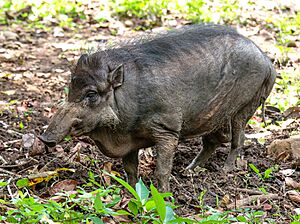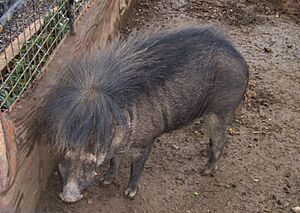Philippine warty pig facts for kids
Quick facts for kids Philippine warty pig |
|
|---|---|
 |
|
| Conservation status | |
| Scientific classification | |
| Genus: |
Sus
|
| Species: |
philippensis
|
 |
|
The Philippine warty pig (Sus philippensis) is a special kind of wild pig. It is one of four pig species found only in the Philippines. These pigs have unique features like tufts of hair on their heads and jaws. They also have four "warts" on their faces.
Male Philippine warty pigs are usually bigger than females. They also have larger skulls and tusks. This difference between males and females is called sexual dimorphism. The IUCN (International Union for Conservation of Nature) lists these pigs as Vulnerable. This means their numbers are decreasing because of many threats. These pigs are likely active mostly at night.
A scientist named Alfred Nehring first described this species in 1886. Today, three different types, or subspecies, of the Philippine warty pig are recognized.
Contents
What They Look Like
Philippine warty pigs usually have black or dark brown fur. They have clear white tufts of hair on the sides of their lower jaws. Male pigs have four "warts" on their faces. Their tusks and jaw tufts are bigger and more yellowish than those of females.
In general, male pigs in the pig family are much larger and have bigger tusks than females. Philippine warty pigs also have hair tufts on the top of their heads. These are called crown tufts. They also have small "manes" on the back of their necks. Their heads are long and slope downwards.
Like many pigs in the Sus genus, their lower canine teeth are shaped like triangles. These canine teeth curve upwards and form the male pigs' tusks.

Pig Family Tree
The Philippine warty pig, Sus philippensis, was first officially described in 1886. This was done by a German zoologist named Alfred Nehring.
Different Types of Philippine Warty Pigs
There are three recognized subspecies of the Philippine warty pig:
- S. p. philippensis: This type lives on Luzon and nearby islands. It has a grey crown tuft that points forward. It also has large warts. Nehring described this subspecies in 1886.
- S. p. mindanensis: This type is found on Samar, Leyte, and other islands near Mindanao. It has small warts. Its crown tufts are black and reddish-brown. Males usually have bigger skulls than females. A Swiss zoologist, Charles Immanuel Forsyth Major, described this type in 1897.
- S. p. oliveri: This subspecies comes from Mindoro. It was described more recently in 2008 by Colin Groves, a biologist. This description was based on three skulls and part of a skin. These pigs have "straw-colored" jaw tufts. Their black crown tufts are mixed with straw-colored hairs.
Where They Live
The Philippine warty pig is one of four pig species found only in the Philippines. The other three are the Visayan warty pig, the Mindoro warty pig, and the Palawan bearded pig. All of them are rare members of the pig family.
Originally, S. philippensis lived on the western islands of the Philippines. The Visayan warty pig lived on the central and eastern islands. Philippine warty pigs were found on Luzon, Biliran, Samar, Leyte, Mindoro, Mindanao, Jolo, Polillo, and Catanduanes. They might have lived on other islands too. They are no longer found in Marinduque.
Wild pigs have been seen in Bohol and Sibuyan. However, it's not clear if these are Philippine warty pigs or Visayan warty pigs. In 2022, a Philippine warty pig was seen by a team climbing Mount Apo.
How They Live
The areas where Philippine warty pigs live are getting smaller and more spread out. They used to live in many different places, from sea level up to high mountains. Now, they are mostly found in remote forests. This is because their homes are being destroyed or broken up. They are also hunted a lot. A serious illness called African swine fever also affects them. Wild pig meat can be very expensive in the Philippines.
Cameras set up in the wild suggest that these pigs prefer open areas. They seem to do well near clearings or farms. They even live in banana plantations.
A study in 2022 showed that these pigs are "ecosystem engineers." This means they change and affect their environment. They help spread seeds and influence how plants grow. They also affect soil erosion. In areas where humans have disturbed the land, these pigs are mostly active at night.
Not much is known about how these pigs reproduce. However, most pigs have between one and twelve babies in a den. The piglets usually leave the den after about ten days. They can have their own babies when they are about 18 months old. One generation of pigs usually lasts about seven years.
Mixing with Other Pigs
Because their natural homes are being lost, Philippine warty pigs sometimes come into close contact with domestic pigs. Domestic pigs are a tamed type of the Eurasian wild boar. This close contact can lead to a big problem called genetic pollution. This happens when the Philippine warty pig mixes with domestic pigs. This mixing, or hybridization, is a major threat to the wild pigs.
See also
- Wild pigs of the Philippines


